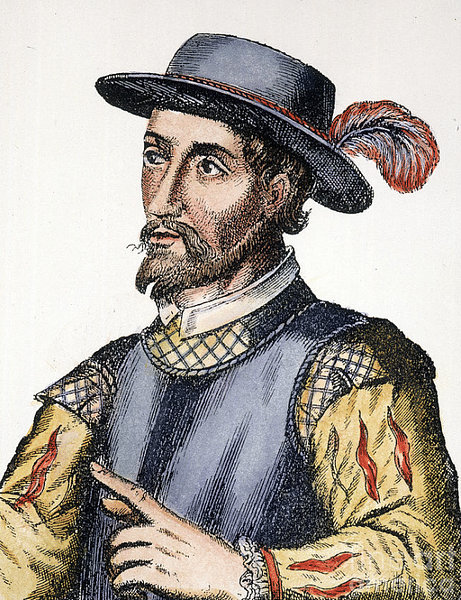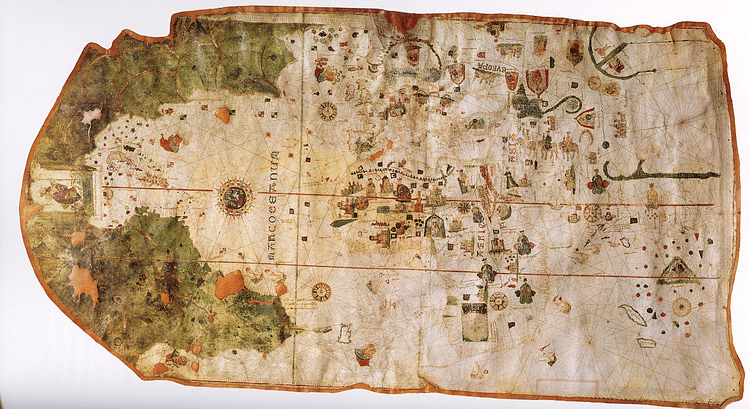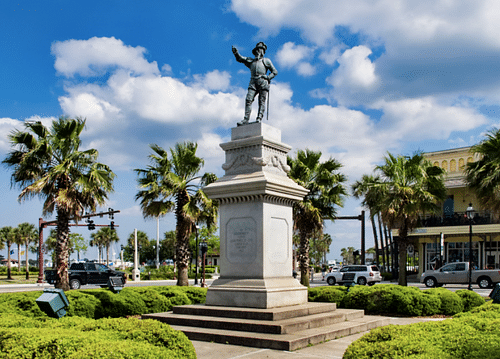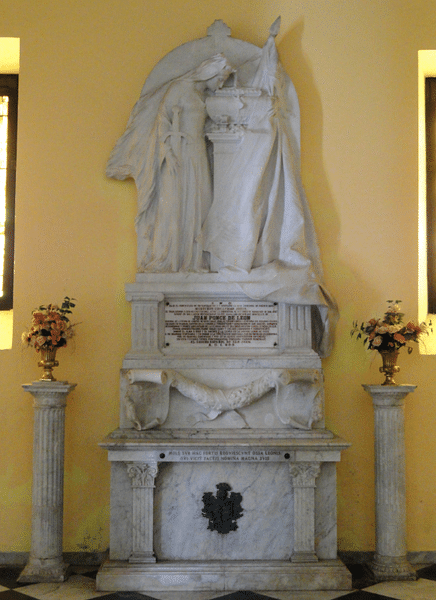
Juan Ponce de León (1474-1521) was a Spanish conquistador who led expeditions from Puerto Rico to the coast of Florida, giving the region its current name. He also served as the first governor of Puerto Rico and discovered the Gulf Stream. He died following a skirmish with indigenous peoples on a second voyage of exploration to Florida in 1521.
Birth & Early Life
Juan Ponce de León was born in 1474 in Santervás de Campos in Valladolid province in northern Spain. He was born into a wealthy family and was given a good start in life when he was made a royal page at the Aragon court. Reaching maturity, Juan learnt to become a knight and fought in Granada against the Moors. But Juan was looking for even greater fame, fortune, and adventure, and so he joined the second voyage to the New World led by Christopher Columbus (1451-1506) in 1493.
The New World: Hispaniola & Puerto Rico
Spanish exploration of the Americas began with the first voyage of Christopher Columbus in 1492. There then proceeded a series of expeditions to colonise territory, starting with the island of Hispaniola (modern Dominican Republic/Haiti) in 1494. The Spanish next moved through the Caribbean to Puerto Rico in 1508, Jamaica in 1509, and Cuba in 1511. They were seeking natural resources, especially gold and silver, but also slaves and land which had the potential for agricultural development and to support colonies. There were also those who wished to spread the Christian religion.
Ponce de León arrived in Hispaniola in 1493, and he decided to settle there, serving under the governor Nicolás de Ovando who made him responsible for the eastern part of the island. The town of La Isabela was founded in 1494 and Santo Domingo in 1498. Cattle, horses, and mules were shipped in from Europe, and plantations were established, growing such crops as sugar and tobacco. Slaves were used to work these plantations, both indigenous people and West Africans brought by ship across the Atlantic. Between 1504 and 1506, Ponce de León married the daughter of a local innkeeper.

Around 1508, Ponce de León moved on to Puerto Rico (then called San Juan). There he subdued the local peoples and claimed the island for Spain. He was made the island's first governor in 1509. The Spanish had established control over the local Taíno people (a branch of the Arawak Indians) with some ease since they were peaceful agriculturalists and had no weapons to match those of the Europeans, like firearms, crossbows, and gunpowder. Ponce de León settled at Caparra and changed the name to Ciudad de Puerto Rico. The search for gold – which was based on unsubstantiated rumours – through the creation of several mines proved a disappointment and succeeded in only killing many of the Indians who had been forced to work below ground. Only when sugar plantations were planted from 1511 did the island begin to produce serious revenue for the Europeans. The port of San Juan in Puerto Rico then became an important stop for the Spanish treasure fleets to the Caribbean. Ponce de León served as governor only until 1511 when the position was taken over by Diego Columbus (c. 1479-1526), the eldest son of Christopher and heir to his father's land titles. Still useful to the Spanish Crown, Ponce de León was instructed by King Ferdinand II of Aragon (r. 1479-1516) to secure the island of Bimini (in the western part of today's Bahamas).
Florida & the Gulf Stream
In March 1513, Juan Ponce de León funded a private expedition to explore what we now know is the coast of northern America to ascertain its potential for resource exploitation. It was already known that indigenous peoples came from the north in canoes to the Bahamas, taking some five or six days, and so it seemed worth exploring just what lay in that direction. Ponce de León commanded a small fleet of three ships, including two caravels: Santiago and María de la Consolación.
Ponce de León sailed as far north as the area which is today the state of Florida. On March 27, they had their first sighting of terra firma, and on 2 April 1513, they landed somewhere between what is today St. Augustine and Melbourne Beach on the eastern coast of Florida (Turner, 9). Consequently, Ponce de León is credited with making the first documented landing in Florida by a European. It is likely that the explorers thought they had simply discovered another large island like those they were so familiar with in the Caribbean. Ponce de León named this area Pascua Florida as he was impressed by the abundance of flowers and general greenery, and the day they had first sighted land was Easter Sunday. He sailed along the coast for three days heading north before turning back and exploring the Florida Keys and the west coast of the peninsula. Indigenous settlements were sighted, but there was no record made of any interaction, friendly or otherwise, until several brief skirmishes at the end of April and early May at the tip of the Florida peninsula.

On the return journey, Ponce de León discovered the phenomenon of the Gulf Stream. This natural and fast movement of the Atlantic Ocean from west to east, along with accompanying warmer air, would prove to be a very useful navigational aid thereafter, and for the Spanish, it meant they now had a relatively easy means to ship looted goods from the Caribbean back to Spain.
On 21 June, Ponce de León's expedition encountered a group of islands in the Florida Keys they called the Tortugas for the great number of turtles in the area. They then proceeded in a roundabout way to either Cuba or the coast of the mainland, the Yucatán peninsula of Mexico, via the Bahamas. A legend has arisen that Ponce de León was not really interested in land or riches in the New World but was actually seeking the "fountain of youth", the magical spring that provided eternal life if one only drank from its waters. There is very little evidence that this was ever his ambition. In October 1513, he returned to Puerto Rico, where the success of his voyage resulted in him returning to Spain in triumph. He was rewarded in September 1514 by being made captain-general, in effect, the military governor of Bimini and Florida. A failed raid on the Lesser Antilles seems to have dulled Ponce de León's star, and his career then stalled for the next five or six years.
Second Voyage to Florida
In the summer of 1521, Ponce de León was back exploring the North American coast and seeking a site suitable for the first Spanish colony there. The Spanish Crown, now in the hands of Charles V, Holy Roman Emperor (r. 1519-1556), had agreed to give the conquistador and his crews the right to everything they found with only a tax being imposed on any gold or silver discovered or looted. Back in February, Ponce de León had written the following letter from Puerto Rico to the emperor outlining his purpose:
Among my services I discovered, at my own cost and charge, the Island Florida, and others in its district, which are not mentioned as being small and useless; and now I return to that island, if it please God's will, to settle it, being enabled to carry a number of people with which I shall be able to do so, that the name of Christ may be praised there, and Your Majesty served with the fruit that land produces. And I also intend to explore the coast of said island further, and see whether it is an island, or whether it connects with the land where Diego Velasquez is, or any other; and I shall endeavor to learn all I can. I shall set out to pursue my voyage hence in five or six days.
(Frederick Davis, 57)
Ponce de León led two ships and some 200 men with 250 horses. His ships also carried a wide variety of livestock, plants, and seeds to be used in the new colony. There were, too, a number of priests and friars on board to convert any locals they encountered. Landing on the east coast of Florida, most likely near Charlotte Harbor, his party was attacked by a local tribe who surprised the Europeans with their ferocity. Around 80 Spaniards were killed, and Ponce de León was himself wounded by an arrow. Ponce de León made good his escape, but he died in Cuba from his wounds in July. As it turned out, the Spanish authorities did little to follow up Ponce de León's exploration and left Florida alone until French Huguenots began to develop settlements there in the 1560s.
Legacy: The Conquest of the Americas
The Spanish were at this point more concerned with Mexico. The governor of Cuba, Diego Velázquez de Cuéllar, had sent several expeditions to explore the mainland coast of America starting in 1517. The 1519 expedition led by Hernán Cortés (1485-1547) encountered the Aztec civilization in Mexico, and by 1521. this empire had fallen, destroyed by a combination of European diseases, rival peoples like the Tarascan civilization joining forces with the Spanish, and the superiority of European firearms and cavalry. One of Ponce de León's expedition ships had even helped with the attack when it landed in Yucatán on the return route of his final expedition to Florida.
Systematically and ruthlessly, the culture of the ancient Mesoamericans, a heritage going back millennia, was repressed and where possible eradicated in an effort to install the new order of the Old World. The same story would become the fate of the Incas in South America when Francisco Pizarro (1478-1542) arrived there in 1532. The Aztec Empire became the Viceroyalty of New Spain, and the Inca territories became the Viceroyalty of Peru. Juan Ponce de León was one of the early conquistadors who had turned the Spanish Empire in the Americas into a reality, creating a springboard from the Caribbean via which the Spanish Main could be established.
Juan Ponce de León's remains today lie in the St. John the Baptist Cathedral of San Juan, Puerto Rico. He is commemorated with several public statues, notably in the places he is most associated with: San Juan and Florida. In addition, the city of Ponce in Puerto Rico is named after him.







